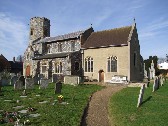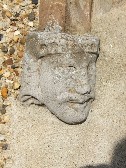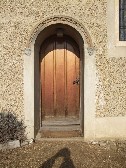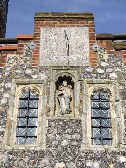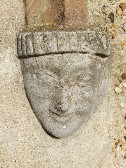| |
|
St
Margaret, Old Catton, Norwich
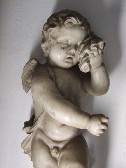 |
|
The
centre of Norwich sprawls into its suburbs like a
ripe fruit which has burst open, but carries with
it very little of the character of the heart of
the city, which is, after all, one of the most
important city centres of its size in Europe as
far as historical architecture goes. The medieval
walls defined the city until well into the 19th
Century, but unlike Ipswich, which expanded
rapidly onto largely uninhabited heathland,
Norwich expanded to engulf villages which in some
cases had grown up fairly close to its walls. Because of
this, there are pockets of interesting
pre-Victorian buildings out in the suburbs;
although, as Pevsner observes, none of the
perambulations of outer Norwich lend themselves
to coherent walks, such are the distances
involved, and, it should be admitted, the paucity
of worthwhile buildings other than in a few
places. Generally, suburban Norwich is more
interesting to the south and west than to the
north and east. But there are exceptions, and
here to the north of the city centre is one of
them.
|
The old
village of Catton has been taken into the urban area, and
the 19th Century suburb of New Catton has grown up beside
it, but the old village is still discernible amogst the
moden estates, and the two main village streets still
have a rural feel, despite (or perhaps because of) the
way that the old village high street now becomes the
airport perimeter backroad as it leaves Norwich to the
north. At right angles to this, not far from the main
road out of Norwich, is the church lane, and St Margaret
sits in its pretty graveyard lifting its entirely rural
round tower above the suburbs, a saving remnant. Seen
from the south, the huge north transept and aisle are
hidden, and in fact St Margaret is an excellent example
of the way in which a rustic, ancient building was
reinvented in the 19th century to served the needs of an
expanding industrial city.
There are
some fine 18th Century headstones to the south of the
church, and a massively overblown memorial of the
following century to the north-east. The short nave and
south aisle are hunched attractively against the round
tower with its elegant octagonal bell turret. There is a
clerestory of just three windows. The south porch has a
good sundial, and a modern statue of St Margaret sits in
the niche between the parvise windows.
The south
side of St Margaret gives the impression that this is a
tall, narrow church, and it was therefore slightly
disorientating to step into a space with a very different
character. The south door leads under the low west
gallery, and an enormous north aisle spread out before
me, an arcade separating it from the former north
transept. It is as if a larger, newer, squarer church had
been grafted on to the side of the old one. Walking
eastwards, I turned back to see the 18th century gallery
decorated in a curious Gothick style. This may well have
been part of an eccentric 19th Century restoration by
that maverick architect Thomas Jekyll. There are
reminders of this in several parts of the church, as well
as more conventional 19th century work. Dark benches are
shoehorned into the short nave, and either side of the
three arcades. If you stand in the far north-west corner,
the impression is of looking through a forest of stone
and woodwork, illuminated by the colours of 19th century
glass.
The rich,
intimate character of St Margaret is partly a result of
this wood and the glass, but also of an exceptionally
good collection of memorials. As ever when we are within
ten miles or so of Norwich, we are reminded that until
the 18th Century Norwich was still the second most
important city in England; the memorials that survive
demonstrate the wealth and significance of some of its
citizens. Old Catton's church is similar in this respect
to the much larger medieval parish church at Sprowston, a
mile or so off.The most important of the memorials here
Is Richard Westmacott's 1820 memorial to a former mayor
of Norwich, Jeremiah Ives, but more spectacular is that
of a century earlier to the Green family, signed by the
Norwich mason Robert Page. There are several other good
wall tablets of the 18th, 19th and 20th Centuries.
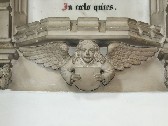 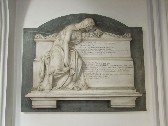 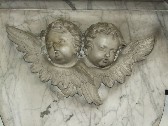 
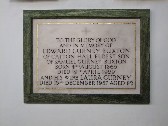 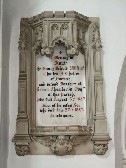 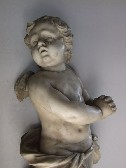 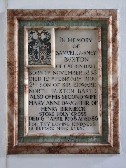 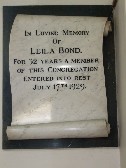 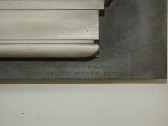
Otherwise,
the character of St Margaret is entirely Victorian. There
is some good glass in the north aisle by the King
workshop, and a curious range of Saints in a medieval
style in the south aisle, probably dating from the Jekyll
restoration.The best of the glass is Clayton & Bell's
Faith, Hope and Charity. The new south south aisle, north
aisle and north transept were all added under the
influence of Richard Hart, who was Vicar here for forty
years in the middle decades of the 19th Century. The work
was largely bankrolled by the Buxton and Gurney families,
and the gallery shields and rose window at the east end
of the south aisle demonstrate the freedom which was
given to Hart's imagination and Jekyll's
pre-ecclesiological sympathies.
| Apart
from a small surviving piece of roodscreen,
hardly anything survives from the medieval life
of the church. There is another good modern
statue of the church's patron sitting in a pretty
little 14th Century niche partway down the north
arcade; the niche is exactly the kind of thing
which you might find it some tiny, remote church
out in the Norfolk fields. Roughly contemporary
with it, but speaking of a quite different kind
of building, is the wholly urban 16th Century
pulpit. It actually came here from St George
Colegate, bought by Richard Hart at the time of
the restoration there, and is of the quality you
would expect to find in a large church in a major
city. St Margaret is a pleasing
combination of the old and new, and although the
interior leaves you in no doubt that this is not
a backwater, the building is mindful of its rural
past. And of the recent past of its parishioners,
too: a moving little brass plate by the south
door recalls that the heating apparatus in
this church was installed by WRC Howlett... as a
thank offering to Almighty God for the
preservation of his three sons during the Great
War, and his own recovery from a serious
accident, Autumn AD 1919. How fortunate he
was.
|
|
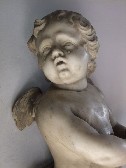 |
|
|
|

